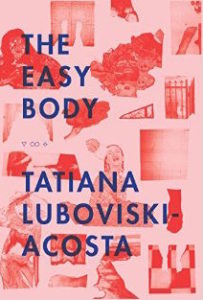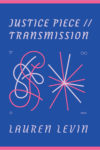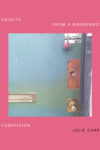 [Timeless, Infinite Light; 2017]
[Timeless, Infinite Light; 2017]
Wreck your body fully and remind it of me. —Tatiana Luboviski-Acosta
First, let me be clear when I say: this book was not written for me. This book was not meant to be dissected within the scope of our historically white, patriarchal literary canon. This book is for the marginalized—the oppressed. This book punches my gut and wrenches and I cannot skirt around the issue of my positioning, or pretend that my critique absolves me of my privilege. For I have the easy body. I perpetuated evil. I sleep the sleep of white girls.
That being said, one of my fondest memories of bearing witness to Luboviski-Acosta read from this work was in a big-windowed warehouse in Los Angeles at an offsite reading during AWP in 2016, when they stood atop a six-foot ladder, and while throwing a dozen eggs down, one by one, into a yellow, viscous splatter on the floor, they yelled out: I…DON’T…CARE…ABOUT…YOUR…WHITE…FRAGILITY! Luboviski-Acosta’s work, as a Latinx performance artist, writer of fire; ice queen—does not give a fuck about your fragility. To experience it firsthand is to be both seduced and horrified, then seduced again. Their fierce words tongue you closer at the tip then bite with malicious delight, to draw just the slightest drip of blood. The Easy Body, published by Timeless, Infinite Light this year is no exception.
This is a long love letter to hell, but to call it epic would oppress its very form. For there is no Hero. The Easy Body has no static protagonist. Luboviski-Acosta writes from many bodies: brown/Latinx bodies, female bodies, chronically ill bodies, mother bodies, queer bodies, earth bodies, celestial bodies, dopesick bodies. Bodies of inherent struggle and suffering: “Bodies that are borders, hiding. / Never have I ever / possessed the pleasures / of having the easy body.”
The identity of the systemically oppressed body cannot be singular; Luboviski-Acosta shows us this in one painfully seamless dance. The continuity of the form borders on brutal – only periodically is the text intervened by fragmented, almost Cubist bodies and their parts. Dismembered feet learning how to walk. Luboviski-Acosta’s visual art dares you to look twice, for the flower may be guised as a gun. A smear of dark pigment is likely blood. The oppressed body must expand, breach, and shape-shift in order to survive: “our bodies / adapted: we grew and split into mirrors; we blistered and / replaced the meadows.” In particular, the transparent pages in the artist edition of The Easy Body seem to act as layers for this self-constructed multifaceted identity. I’ve heard these pages referred to as “scar tissue,” conjuring up a fleshy treatise on survival. They seem to float in their emptiness and at their turning, subtly build into a collage of being. A traced record, or imprint: of bodies.
Luboviski-Acosta leads us, as we walk bare-footed over broken glass, closer to the fire – and they’ve set the fire themselves. They lead us to the River Styx, carrying the bodies that cannot sustain their living. Here, Luboviski-Acosta takes our concept of evil and turns it right on its head. Evil has many functions in The Easy Body, and it’s impossible to ignore the nuances, degrees, and seeming contradictions of the ways in which evil operates in this work. The most obvious form of evil is that committed by the oppressor. Luboviski-Acosta draws our attention, rather, to the way in which the evil oppressor conditions the oppressed person into believing that they are evil. One could argue that acts of evil beget new definitions of evil – evil gets creative in its choosing. Just as evil has many functions in The Easy Body, so too does oppression, particularly the oppression of the mentally ill mind. Oppression of the addicted mind. Oppression of the impressionable mind. Luboviski-Acosta asks their readers, in earnest: “how could someone oppressed not be viewed as evil?”
It is easier for a highly Christian-governed society to believe that the demographic of people they cast aside are intrinsically bad seeds. This does not only apply to race, of course, but also extends to gender politics, sexual orientation, and whether or not you are able-bodied. Women, for instance, are historically perceived as evil merely because our menstruation cycle coalesces with the lunar cycle. If the woman can spawn life, she too must be able to destroy life:
I also know this is a dream from the devil. I don’t mind.
The devil is what brought balance to the world, and the
world is dying from too much of too many good things.I am truly an evil woman. I am probably from that eternal
and lush paradise to the south, beneath the permanent
frost. A rotting garden melting ice and flooding the world,
releasing what clouds breathe to seduce the sun.
Maternal autonomy is so frightening to white men in legislature that they write bills advocating that women’s bodies must be governed by the state. There is no easy choice; that is, there is no choice for the marginalized bodies, nor has there ever been. Particularly not when our current administration has essentially defined the female, LGBTQIA, differently abled, and/or bodies of color as in themselves pre-existing conditions. We live in the wake of slavery, warfare, and genocide. Revolution begins when the oppressed become the masters of their own death and rebirth, and perhaps it succeeds when this autonomy is never put into question again. Luboviski-Acosta reclaims this power, namely: the power to destroy. The Easy Body begins by taking a poll:
how many of us
grew up praying for
the end of the world? Is it
so bad to desirethe end of the world?
Transcribing a codex for
The dissolution of selfas I sit on your
face, calling for theend of the world.
A woman nearing apocalypse cannot be a mother (one can’t help but think of Sethe haunted by her dead child in Toni Morrison’s Beloved). One cannot love safely. In Luboviski-Acosta’s dystopic myth, all of time exists on one plain. The ancestors cannot be forgotten and in this way the past is inescapable. This is a world of carnage, blood, vomit, shit, and scars to show for it. A cathartic spit. Miles and miles of hair; women braiding it. A world where all men must die and the woman’s only death is a little one.
In the end of this raw, unwavering scream; this ceremony of the dead, we cycle back and end with this apocalyptic destruction, like a maternal wrath, echoing back into the belly of doom. The veil has been lifted, and for the first time we hear the speaker’s voice. It’s as if they’ve risen from the nightmare, but there is no solace when this nightmare runs through their blood. Luboviski-Acosta bled onto these pages; cherish every line, however jagged, or rough.
I held this book and cried.
Hannah Kezema is an east coast-born artist living in the Santa Cruz redwoods by the sea. She holds an MFA in Writing & Poetics from the Jack Kerouac School of Disembodied Poetics at Naropa University and a BA in Literature from The New School. Along with Angel Dominguez, she co-founded the performance art collaborative DREAM TIGERS (http://dreamtigering.tumblr.com). She was the semi-finalist for 1913 Press’s 2015 First Book Prize, with her manuscript (where the light can’t reach) and her chapbook, Three, is forthcoming from Tattered Pages Press in October of 2017 (http://www.tatteredpress.org/hannah-kezema).
This post may contain affiliate links.







